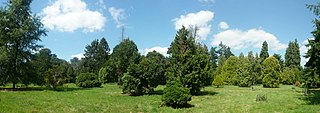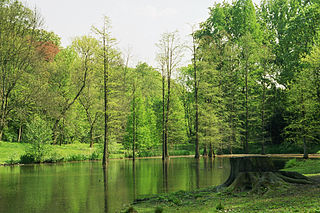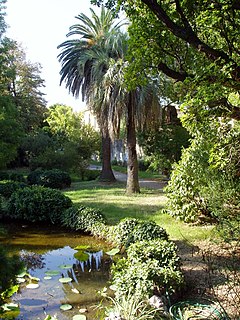
The Connecticut College Arboretum is a 300 ha arboretum and botanical gardens, founded in 1931, and located on the campus of Connecticut College and in the towns of New London and Waterford, Connecticut, United States.
Secrest Arboretum is an arboretum located on the campus of the Ohio Agricultural Research and Development Center (OARDC), at the intersection of Pine Road and Green Drive, Wooster, Ohio. It is open daily without charge and hosts an estimated 10,000 visitors each year.

Chadwick Arboretum is a 62 acres (25 ha) arboretum on the Agriculture campus of The Ohio State University, in Columbus, Ohio, United States. The main arboretum collection is located just across Lane Avenue from the Schottenstein Center with its other collections nearby. The arboretum is open daily without charge.

The North Carolina Arboretum is an arboretum and botanical garden located within the Bent Creek Experimental Forest of the Pisgah National Forest at 100 Frederick Law Olmsted Way, southwest of Asheville, North Carolina near the Blue Ridge Parkway. It is open daily except for Christmas Day. There is no admission charge, but some parking fees do apply.
The Tsytsin Main Moscow Botanical Garden of Academy of Sciences was founded in April 1945, and claims itself to be the largest botanical garden in Europe. It covers a territory of approximately 3.61 km², bordering the VDNKH Exhibition Center, and contains a live exhibition of more than twenty thousand different species of plants coming from various parts of the world. The garden also has a scientific research laboratory and contains a rosarium with twenty thousand rose bushes, a dendrarium (arboretum), an oak forest with the average age of the trees exceeding 100 years, a Japanese garden and a greenhouse of more than 5000 square meters.

The Koishikawa Botanical Gardens are botanical gardens with arboretum operated by the University of Tokyo Graduate School of Science. They are located at 3-7-1 Hakusan, Bunkyō, Tokyo, Japan, and open daily except Mondays; an admission fee is charged.

The Tsukuba Botanical Garden is a major botanical garden near the University of Tsukuba at 4-1-1 Amakubo, Tsukuba, Ibaraki Prefecture, Japan. It is open daily except Mondays; an admission fee is charged.
The Botanic Gardens of Toyama are botanical gardens located at 42 Kamikutsuwada, Fuchu-machi, Nei-gun, Toyama, Toyama, Japan. They are open daily except Thursdays; an admission fee is charged.
The Tropical & Subtropical Arboretum is a 9-hectare (22-acre) arboretum and botanical garden located in the southern tip of the Ocean Expo Park at Ishikawa 424, Motobu-cho, Kunigami-gun, Okinawa, Japan. It is open daily without charge.
The Experimental Station for Landscape Plants, also called the Kemigawa Arboretum, is a research and plant-breeding arboretum operated by the University of Tokyo Faculty of Agriculture, and located at Hata-machi 1051, Hanamigawa-ku, Chiba, Chiba, Japan.
The Niigata Prefectural Botanical Garden is a 19.8 hectares botanical garden and arboretum located at 186 Kanazu, Akiha-ku, Niigata, Niigata, Japan. It is open daily except Mondays; an admission fee is charged.

The Orto Botanico dell'Università di Torino is a botanical garden and arboretum operated by the Dipartimento di Biologia Vegetale of the University of Turin. It is located in the Parco del Valentino along the Po River, at Viale Pier Andrea Mattioli, Turin, Italy, and open weekends and holidays during the warmer months; an admission fee is charged.
The Jardin botanique de la Faculté de Pharmacie, more formally the Jardin de la Faculté des Sciences Pharmaceutiques et Biologiques de l'Université de Lille 2, is a botanical garden and arboretum operated by the Faculty of Pharmacy of the Université de Lille 2. It is located at 3 Rue du Professeur Laguesse, Lille, Nord, Nord-Pas-de-Calais, France, and open weekdays except university holidays; an admission fee is charged.

The Arboretum de Versailles-Chèvreloup is a major arboretum located just north of the Palace of Versailles at 30, route de Versailles, Rocquencourt, Yvelines, Île-de-France, France. It forms part of the Muséum national d'histoire naturelle, and is open evryday in the warmer months; an admission fee is charged.

The Botanischer Garten Rombergpark, or informally Rombergpark, is an extensive municipal arboretum and botanical garden located at Am Rombergpark 49b, Dortmund, North Rhine-Westphalia, Germany. With its total area of 65 hectares the Rombergpark is one of the largest botanical gardens in the world. It is open daily.
The Forstbotanischer Garten und Pflanzengeographisches Arboretum der Universität Göttingen, often called the Forstbotanischer Garten und Arboretum, is a 40 hectares arboretum and botanical garden maintained by the University of Göttingen. It is located at Büsgenweg 2, Göttingen, Lower Saxony, Germany, immediately adjacent to the New Botanical Garden, and open to the public daily.

The Old Botanical Garden of Göttingen University, with an area of 4.5 hectares, is an historic botanical garden maintained by the University of Göttingen. It is located in the Altstadt at Untere Karspüle 1, adjacent to the city wall, Göttingen, Lower Saxony, Germany, and open daily.

The Botanischer Garten Münster is a botanical garden maintained by the University of Münster.
University of the Philippines Arboretum, also known as UP Arboretum, is a botanical garden located on the campus of the University of the Philippines Diliman in Quezon City, Philippines. It lies at the northern part of the village of U.P. Campus between the U.P.-Ayala Land TechnoHub on Commonwealth Avenue to the south and Central Avenue and the village of Culiat to the north, close to the Philippine Nuclear Research Institute. The 16-hectare (40-acre) man-made forest garden houses a collection of more than 9,000 tropical plants of about 77 unique species. It is one of few rainforests of its size located entirely within Metro Manila.
















